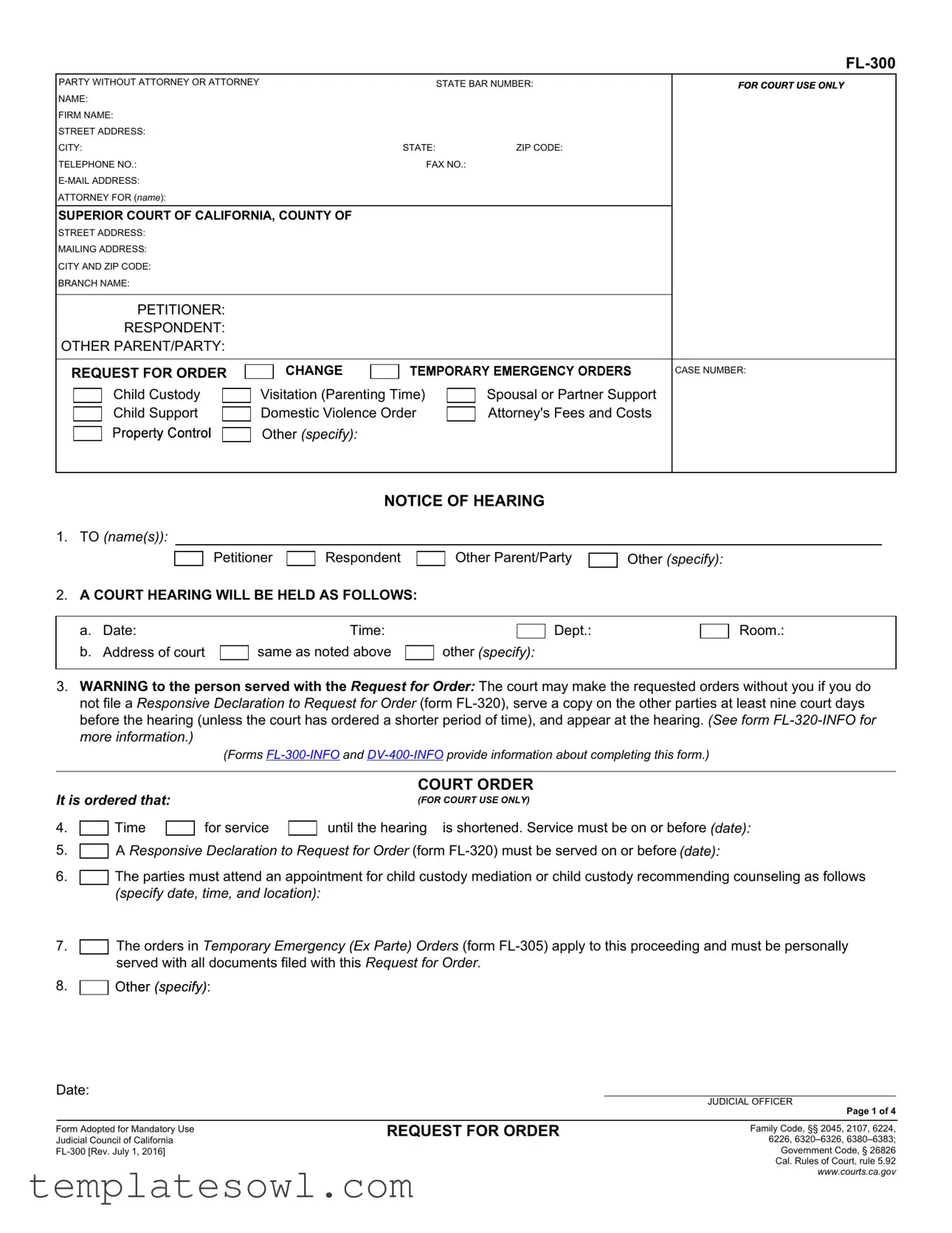What is the FL-300 form used for?
The FL-300 form is a "Request for Order" that individuals in California can use to ask the court for specific orders related to family law matters. These include issues like child custody, visitation, child support, spousal support, and property control. This form is particularly important for parties seeking to modify existing orders or establish new ones in family court.
Who needs to fill out the FL-300 form?
The form must be filled out by individuals who are involved in family law cases and wish to request changes or establish new orders. This could include a petitioner or respondent in a divorce or custody case, or any party with standing regarding the matters at hand.
How do I complete the FL-300 form?
To complete the FL-300 form, individuals should provide their name, contact information, and details about the order they are requesting. Sections of the form must be completed based on the specific orders being requested, including child custody, visitation, or spousal support. It’s important to include relevant dates and attach any necessary documents to support the request.
What happens after I submit the FL-300 form?
After submitting the FL-300 form, a court hearing will be scheduled. The parties involved will receive a notice about the date, time, and location of the hearing. It's crucial for all parties to attend, as the court may make decisions in their absence if they do not respond adequately.
How should I serve the FL-300 form?
The completed FL-300 form must be served to all other parties involved in the case. Service should be completed at least nine court days before the scheduled hearing. This means delivering a copy of the form and any attachments to the other parties, either in person or via mail, ensuring they receive notice of the request.
What if I need to change the hearing date?
If you need to change your hearing date, you must request a continuance from the court. This typically involves filling out a separate request and demonstrating good cause for the change. Be prepared to propose a new date that is acceptable to all parties involved.
Can I request attorney's fees using the FL-300 form?
Yes, you can request attorney’s fees and costs as part of your FL-300 submission. To do so, you must specify the amount you are requesting and include supporting documentation, such as an Income and Expense Declaration and any relevant attachments indicating the need for fees.
What is the significance of the "Facts to Support Orders" section?
This section allows you to explain the reasons for your request in detail. You need to list facts that support the orders you are asking for from the court. Keep this information focused and concise, adhering to the 10-page limit unless you have permission from the court for more.
Is there assistance available for completing the FL-300 form?
Yes, individuals can seek help from legal aid organizations, some courthouses with self-help centers, or consult with legal professionals to ensure the FL-300 form is completed correctly. Resources are also available online to guide individuals through the process of filling out this form and understanding family law procedures.



 Respondent
Respondent Time
Time The parties must attend an appointment for child custody mediation or child custody recommending counseling as follows (specify date, time, and location):
The parties must attend an appointment for child custody mediation or child custody recommending counseling as follows (specify date, time, and location):























































 petitioner
petitioner  respondent
respondent  other parent/party
other parent/party
 own or are buying
own or are buying I request temporary emergency orders be given exclusive temporary use, possession, and
I request temporary emergency orders be given exclusive temporary use, possession, and
 This is a change from the current order for property control filed on (date):
This is a change from the current order for property control filed on (date):